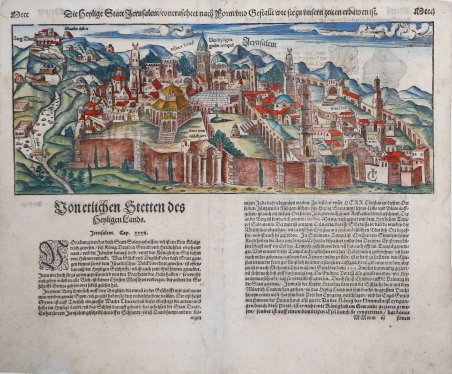Una delle prime vedute a stampa di Gerusalemme, eseguita in xilografia da Jacob Clauser per la Cosmographia di Sebastian Munster. Si tratta di una delle prime immagini disponibili della città; a differenza della maggior parte delle prime rappresentazioni, questa veduta a volo d'uccello non è intesa come una rappresentazione puramente retrospettiva della città antica, ma piuttosto come una visione moderna, che mostra la città al momento della pubblicazione. La mappa è stata disegnata da un cristiano devoto, e quindi molte delle caratteristiche mostrate sono quelle che sono di primario interesse per i pellegrini cristiani. Viene mostrato il tempio dei Cavalieri del Santo Sepolcro e sono disegnati anche il tribunale di Pilato, il palazzo di Erode, il giardino di Gesthemane e l'Akeldama. Come indicato nel titolo, la città era all'epoca occupata dall'Impero Ottomano; al centro è raffigurata la Cupola della Roccia, che è chiaramente una moschea, ma conserva il nome di Tempio di Salomone. L'intera città è rappresentata abbracciata dalle sue antiche mura, con il nome di alcune delle sue famose porte. Tavola tratta dalla ' Cosmographiae Universalis, edizione in tedesco, Basilea, seconda metà del XVI secolo. La ' Cosmographiae Universalis ' di Sebastian Münster (1488-1552), stampata per la prima volta Basilea nel 1544 dall’editore Heinrich Petri, venne più volte aggiornata e aumentata di nuove carte geografiche e rappresentazioni urbane nelle sue numerose edizioni che arrivano all’inizio del secolo successivo. Münster aveva lavorato a raccogliere informazioni al fine di ottenere un'opera che non deludesse le aspettative e, dopo un'ulteriore pubblicazione in tedesco abbellita da 910 stampe su legno, giunse nel 1550 all'edizione definitiva in latino, illustrata da 970 silografie. Vi furono poi numerose edizioni in diverse lingue, fra cui latino, francese, italiano, inglese e ceco. Dopo la sua morte di Münster (1552), Heinrich Petri prima, e il figlio Sebastian poi, continuarono la pubblicazione dell’opera. La ' Cosmographia universalis ' fu uno dei libri più popolari e di successo del XVI secolo, e vide ben 24 edizioni in 100 anni: l'ultima edizione tedesca venne pubblicata nel 1628, molto tempo dopo la morte dell'autore. La ' Cosmographia ' conteneva non solo le ultime mappe e vedute di tutte le città più famose, ma anche una serie di notizie enciclopediche di dettagli relative al mondo conosciuto, e sconosciuto. Il particolare successo anche commerciale di quest'opera fu dovuto in parte alle belle incisioni (tra i cui autori si possono citate Hans Holbein il Giovane, Urs Graf, Hans Rudolph Manuel Deutsch, David Kandel). Silografia, finemente colorata a mano, in ottime condizioni. Bibliografia Laor 1087. One of the earliest printed views of Jerusalem, executed in woodcut by Jacob Clauser for Sebastian Munster's Cosmographia. It is one of the earliest available images of the city; unlike most early representations, this bird's eye view is not intended as a purely retrospective depiction of the ancient city, but rather as a modern view, showing the city at the time of publication. The map was drawn by a devout Christian, and thus many of the features shown are those that are of primary interest to Christian pilgrims. The temple of the Knights of the Holy Sepulcher is shown, and Pilate's court, Herod's palace, Gesthemane's garden, and the Akeldama are also drawn. As indicated in the title, the city was at the time occupied by the Ottoman Empire; the Dome of the Rock, which is clearly a mosque but retains the name Temple of Solomon, is depicted in the center. The entire city is depicted embraced by its ancient walls, named after some of its famous gates. Taken from the ' Cosmographiae Universalis, German edition, Basel, second half of the 16th Century. The ' Cosmographiae Universalis ' of Sebastian Münster (1488-1552), printed for the first time in Basel in 1544 by the publisher Heinrich Petri, was updated several times and increased with new maps and urban representations in its many editions until the beginning of the next century. Münster had worked to collect information in order to obtain a work that did not disappoint expectations and, after a further publication in German embellished with 910 woodblock prints, arrived in 1550 to the final edition in Latin, illustrated by 970 woodcuts. There were then numerous editions in different languages, including Latin, French, Italian, English and Czech. After his death in Münster (1552), Heinrich Petri first, and then his son Sebastian, continued the publication of the work. The ' Cosmographia universalis ' was one of the most popular and successful books of the 16th century, and saw as many as 24 editions in 100 years: the last German edition was published in 1628, long after the author's death. The ' Cosmographia ' contained not only the latest maps and views of all the most famous cities, but also a series of encyclopedic details related to the known, and unknown, world. The particular commercial success of this work was due in part to the beautiful engravings (among whose authors can be mentioned Hans Holbein the Younger, Urs Graf, Hans Rudolph Manuel Deutsch, David Kandel). Woodcut with fine later habd colour in good condition. Bibliografia Laor 1087. Cfr.

Descubre cómo utilizar
Descubre cómo utilizar

